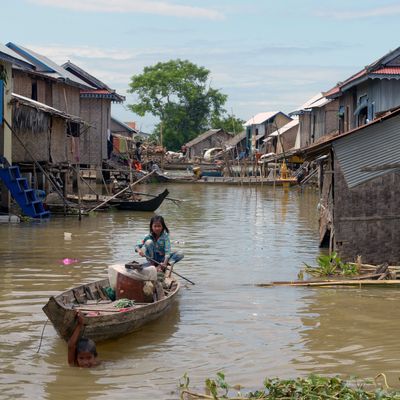
Sometimes, tech that helps the world literally helps the entire world, or at least a big chunk of it. We’ve covered some of those — a counterfeit-pill detection service already serving millions, a treatment for worldwide desertification, drones that deliver blood to people in rural areas. Those are all huge projects with worldwide potential impacts. But there are also plenty of very small, humble projects, no less important for their specificity. A flood-sensing project called Tepmachcha, created as a collaboration between the American DAI Maker Lab and the Czech-based NGO People in Need, is one of those. “The whole world doesn’t need more than 25 of these things,” says Rob Ryan-Silva, DAI Maker Lab’s director. But that doesn’t mean that the world doesn’t need it at all.
Tepmachcha — it’s the Khmer name for the fish form taken by the Hindu god Vishnu to warn of a flood — is an example of how global technology manufacturing can be used to solve incredibly local problems. Developed in mid-2016, the project is a fully open-source flood detector designed for Cambodia, which has been particularly prone to disastrous floods in recent years. The particulars of the tech situation in Cambodia mean that this specific project is really only suited for very low volume.
Flood warnings are often pushed out through mobile alerts, but there are hurdles in Cambodia. Cell-phone access isn’t the problem; Cambodia has more cell-phone subscriptions than people. (The U.S. does, too.) The coverage, says Ryan-Silva, is surprisingly robust and reliable. But in rural areas, illiteracy rates are around 25 percent, quite high. And while cell phones are common, internet connectivity is not. Another problem: The Khmer language is not supported by some of the most popular low-cost Nokia phones used in rural Cambodia. Khmer text just shows up as those Unicode confused white boxes, so even if the phone’s owner can read, the phones won’t necessarily be able to display the text.
One solution is something called Interactive Voice Response, or IVR, which is basically robo-menus. Press one for yes, that kind of thing. But far from being annoying, these IVR systems are essential for both conveying and collecting data, given the problems with text-based communication in Cambodia.
The Tepmachcha system is an open-source project on GitHub: It’s a complete shopping list of hardware components (there are links to the specific ones that work with the software; AliExpress is helpful), plus software to make it all work. The end product is a box containing a sonar detection system, a microprocessor similar to an Arduino, a solar panel, a battery, and a chip to communicate with cell networks. The box is dangled over a stream (usually off of a bridge, to be in the middle of the stream), with the sonar pointing downward. It bounces that sonar off of the surface of the water to detect the water level; if the level rises too high for that particular stream, it sends an alert to People in Need, which sends out an IVR call. Within minutes, people downstream of a dangerous stream can get a warning they can understand.
It’s an opt-in system, one of many operated by People in Need. They currently have about 72,000 subscribers, and 16 Tepmachcha units in the field. (More are coming; shipping components from China to Cambodia can sometimes mean long waits while packages clear customs.) It’s hard to know exactly how many subscribers for this kind of service are even out there, given its specifics: Target users would have a phone without internet access or Khmer language compatibility, live in a rural area, and maybe have limited literacy. But 72,000 is a pretty huge number given the low cost of the project.
Only in the past decade or so has this kind of low-volume project been remotely feasible economically. Typically, the big factories in China that churn out iPhones and Rokus and Samsung TVs wouldn’t touch something like this; to make a profit, they have to assemble gadgets by the tens or hundreds of thousands. But now they don’t have to; these individual components are already made, and made cheaply, and can be assembled by someone with very little engineering training. The total cost of each of these boxes, says Ryan-Silva, is only $305. And they’ll last indefinitely; a couple of the first ones ever built, which were supposed to be just pilot testers, are still functioning. In the meantime, Ryan-Silva tells me that local coders have already started improving the firmware.